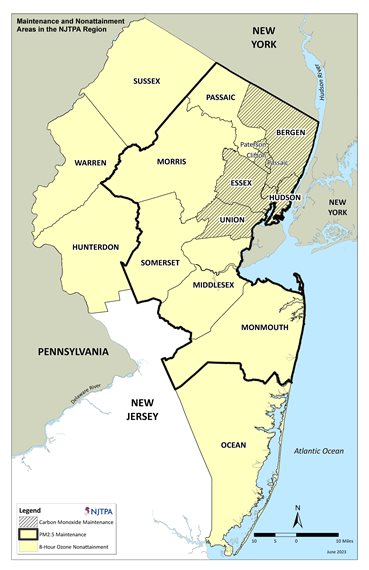Air Quality
The NJTPA is responsible for advancing transportation policies and projects that will help improve air quality in the NJTPA region. As shown on the map below, portions of the NJTPA region are in “nonattainment” (fail to meet the federal standards) for ozone (O3). Also, parts of northern New Jersey are considered a maintenance area for fine particulate matter (PM2.5) and carbon monoxide (CO) as standards have been achieved.

Key air quality related planning activities of the NJTPA include the following:
Transportation/Air Quality Conformity Because portions of the NJTPA region fail to meet the National Ambient Air Quality Standards, the NJTPA is required to demonstrate conformity on all plans, programs, and projects. This means that the NJTPA must demonstrate that the projects it approves through its Transportation Improvement Program (TIP) and Long Range Transportation Plan (LRTP) will have a net positive impact on air quality and contribute to the achievement of the air quality goals contained in the New Jersey State Implementation Plan (SIP). A more detailed summary of the conformity process can be found in this PDF document.
To annually demonstrate conformity, the NJTPA uses computer modeling to estimate the emission impacts of approved projects. To comply with federal regulations, the NJTPA has established procedures for public involvement and interagency consultation. This includes detailed documentation for non-technical readers and an annual workshop on conformity. The latest conformity documents are posted below:
Transportation Clean Air Measures
With action by public agencies and thanks to improvements in vehicle technology and maintenance, the region has seen improved air quality in recent years. Through the Transportation Clean Air Measures (TCAM) program, NJTPA works with partner agencies to develop transportation projects that will reduce harmful emissions and benefit air quality.
Projects funded in November 2020 are described in this article. Project types include electric vehicle charging, bike-pedestrian trails, zero-emission vehicles at the port, idling reduction programs, and signal optimization, among others.
Some past funded projects include:
-
Replacing traffic signals along the length of Route 21-McCarter Highway in Newark, Essex County, with adaptive signals that adjust to traffic conditions in real time. Sponsored by the City of Newark.
-
Implemented a coordinated “smart” traffic signal system including adaptive signals in the Central Business District of Hackensack, Bergen County.
-
The New Jersey Fleet Turnover & Retrofit Program provided competitive grants to private companies to replace off-road diesel construction equipment with less polluting equipment.
-
The North Jersey Regional Truck Replacement Program provided grant incentives for private truck owners to replace old, high-emissions trucks with newer fuel-efficient vehicles. Sponsored by the Port Authority of New York & New Jersey (PANYNJ).
An article on 2015 projects is here. Past projects have included a NJ Transit Locomotive Idle Reduction Program (2011) and a public/private partnership between the Port Authority and Conrail to replace a freight train diesel locomotive engine with new ultra low emitting equipment (2009).